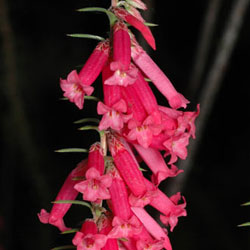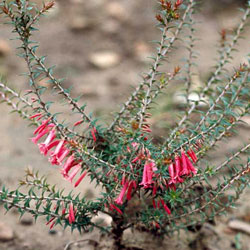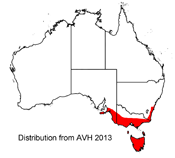Epacris impressa
 |
 |
Pink Heath, Common Heath
Commonly known as Pink or Common Heath Epacris impressa belongs to the Ericaceae family. Its habitat and distribution ranges mainly from the heath to open forests of New South Wales, Victoria, Tasmania and South Australia. It is the floral emblem of Victoria.
 Being 1–1.5 m tall, this plant forms a shrub with stiff branches. The leaves are rigid, alternate with a linear-lanceolate to ovate shape. The flower has five petals, which fuses into a tube. The flowers can form a stem-packing cluster or can be sparse and one-sided.
Being 1–1.5 m tall, this plant forms a shrub with stiff branches. The leaves are rigid, alternate with a linear-lanceolate to ovate shape. The flower has five petals, which fuses into a tube. The flowers can form a stem-packing cluster or can be sparse and one-sided.
Different colour forms are used in cultivation, including ‘Grampians Heath’, 'Cranbourne Bells' and the ‘Bega’ form (one of the most reliable forms in cultivation).
The flowering time lasts from late autumn to late spring with a peak in winter. This long flowering time is one of the reasons why this plant is often sought after in gardens. The fruiting time starts from late July or August and the seeds are collected from September to October.
E. impressa is a widely cultivated species, but is not always easy to propagate. Seed propagation is encouraged if genetic diversity needs to be preserved. Between the harvest and the sowing period, the seeds should be stored in cool, dark and dry conditions for 12–16 weeks. It is advised to sow fresh seeds on the moist soil surface in pots. The seed germination time can be from 2 months to 2 years. This plant can also self-sow all around.
Stem cuttings are usually favoured since it takes less time and is more successful. Cuttings of 7–8 cm long are snipped below the soft tips or semi-woody part from late summer to late autumn. A good soil mix includes sphagnum moss overlaid by fine gravel and peat. The root system takes 9–10 months to develop. Care is required with seedling and rooted cuttings to prevent damaged roots.
This plant needs moisture and grows on well-drained soils, for instance, in sandy or gravelly pots, raised beds or sloped areas. It prefers a slightly acidic soil and can be planted in full sun and semi-shade. A sequence of plantings is recommended to retain this short-lived plant in the garden. Pruning is promoted after flowering to remove the unaesthetic stems, ensuring that the seed capsules are not removed before they ripen.
E. impressa is important for revegetation programs and the horticultural industry for landscaping and providing cut flowers. One of its ecological roles is that it provides nectar for honey-eating birds.
Joanna Li Yung Lung, Botanical Intern 2013
Name meaning: Epacris impressaEpacris – from the Greek ‘epi’ ,meaning upon, and ‘acris’, a summit, which refers to the high altitude habitat of some species impressa – from the Latin meaning indented, referring to the five indentations at the flower base |
References:
Australian Native Plants Society (Australia) (2012) Australian Native Plants Society, Australia, viewed 6 February 2013, http://anpsa.org.au/epacris2.html, http://anpsa.org.au/e-imp.html
Barker, J., Campbell, A., Candy, F., McAllister, P. & Shaumann, M. (2009) Collect and grow that seed – small Australian plants, Barker, J., Campbell, A., Candy, F., McAllister, P. & Shaumann, M., Northcote, Vic.
Boden, A. (1985) Floral Emblems of Australia, Australian Government Publishing Service, Canberra
Feilen, P. (2013) ANBG Horticulturalist, pers. comm..
Powell, J.M. (8 February 2013) Epacris impressa in PlantNET - The Plant Information Network System of The Royal Botanic Gardens and Domain Trust, Sydney, Australia (version 2.0). http://plantnet.rbgsyd.nsw.gov.au
![An Australian Government Initiative [logo]](/images/austgovt_brown_90px.gif)

